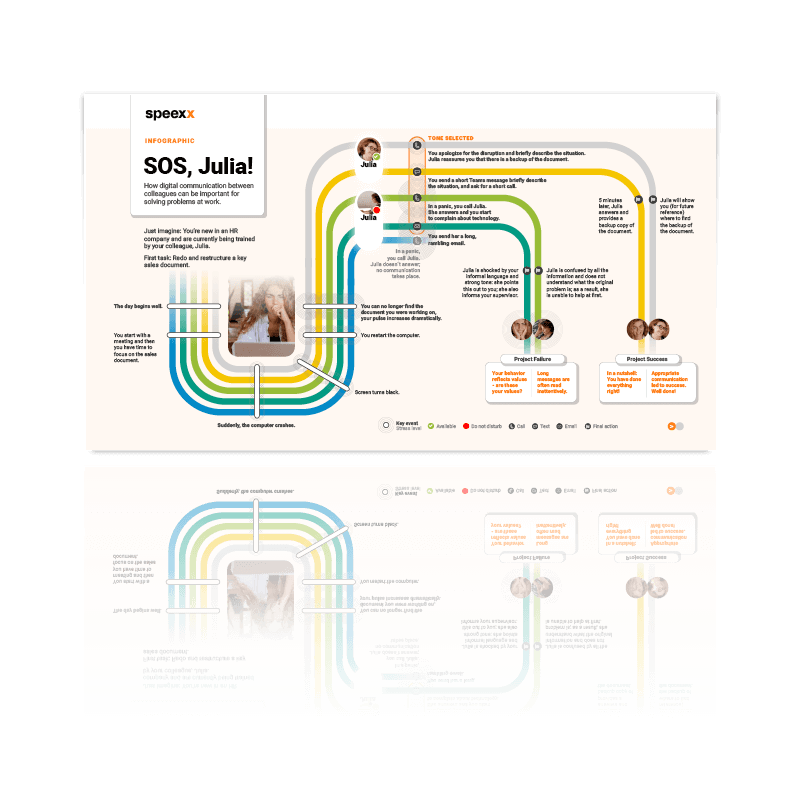If the term “asynchronous communication” leaves you scratching your head, don’t worry—you’re likely already using it every day. Asynchronous communication refers to any form of communication where there’s no expectation of an immediate response, such as emails, SMS messages, or chats on messaging platforms.
In the workplace, synchronous (real-time and immediate) interactions are often prioritized. However, asynchronous communication has its own essential role in fostering productivity and flexibility.
This article explores the role of asynchronous communication in today’s workplace, how it complements synchronous communication, and tips for striking the right balance between the two.
Asynchronous Communication or Synchronous Communication?
Asynchronous Communication
The rise of hybrid and decentralized work models has transformed how teams collaborate, making asynchronous communication increasingly common. Notifications arriving in the middle of the night, once deemed inappropriate, have become routine as teams span multiple time zones.
The key distinction between asynchronous and synchronous communication lies in the expectation of a response. For example, sending an email to colleagues in a different time zone is acceptable because there’s no assumption they’ll reply immediately. This flexibility makes asynchronous communication essential in today’s global workplace.
Synchronous Communication
Synchronous communication, on the other hand, demands an immediate response and relies on real-time interactions, often happening face-to-face or via video calls. Picture starting a conversation with someone who doesn’t reply right away—such a delay would typically feel awkward or even rude.
Asynchronous Communication and Work Quality
Asynchronous communication creates an environment that allows team members to focus on their core tasks without constant interruptions. This approach supports the completion of critical objectives and milestones with greater efficiency and concentration.
While straightforward, this style of communication has a profound impact on work effectiveness, particularly in remote settings where focus can be maximized. Many employees produce their best work in conditions that prioritize uninterrupted attention over the immediate demands of real-time meetings.
Sync or Async: Modern Apps Bridge the Gaps
Asynchronous communication fills the gaps in time and geography where immediate interaction between parties isn’t always feasible. Even in traditional work environments, asynchronous communication serves as a cornerstone of daily professional exchanges. Modern tools and platforms enable collaboration without requiring all participants to be present simultaneously. Platforms like Monday.com and Wrike, along with video messaging apps like Teams and Loom, allow users to access content at any time and provide detailed status updates, making them ideal for accommodating different schedules and working conditions.
Many of these apps also support synchronous, or real-time, communication, which facilitates instant exchanges between employees. Collaborative meetings can occur remotely, in person, or via digital platforms such as Zoom or Slack, ensuring that questions are answered, and feedback is provided immediately.
Advantages of Asynchronous Communication
- Supports deep concentration and workflow, as team members spend less time in meetings and can focus more intensively on their tasks.
- Particularly beneficial for distributed teams across different time zones, where synchronizing communication can be challenging.
- Ensures all communication is recorded, making it easier to review discussions or project details later.
- Promotes more detailed and clear communication, as team members have time to reflect and refine their messages for clarity and completeness.
- Often leads to better solutions, as team members have time to think and develop more thoughtful and effective ideas.
Challenges of Asynchronous Communication
- Time delays can complicate matters, depending on the nature of the message or the intended outcome.
- Writing detailed messages takes time, requiring a significant effort to prepare clear and comprehensive communication.
- Fragmented communication tools can make it difficult for team members to locate necessary information or collaborate effectively.
- A diminished sense of solidarity among team members can arise. Regular team-building exercises can help mitigate this challenge.
- Subtleties conveyed through face-to-face interaction are often lost, which can be critical in discussions requiring nuance, such as feedback or conflict resolution.
So, what are the most commons pros and cons of synchronous (real-time) communication?
Advantages of Real-Time Communication
- Immediate problem resolution is a key strength, making it ideal for addressing urgent matters or working out solutions on the spot.
- Enhances direct communication, which is crucial for discussing sensitive issues, providing constructive feedback, and avoiding misunderstandings.
- Strengthens team bonds through regular, personal interactions that are essential for team morale and individual career development.
- Encourages collective brainstorming and creativity, helping to generate innovative ideas and foster a spirit of teamwork.
Disadvantages of Real-time Communication
- Frequent meetings can disrupt the rhythm of work, interrupt focus, and reduce individual productivity.
- Meetings often lack a defined goal, leading to unnecessary gatherings that could have been handled via email.
- Important ideas and tasks discussed in meetings can be overlooked or forgotten, especially if they are not properly documented.
- Rushed decisions may occur, with team members sometimes making quick choices without fully processing available information or considering alternatives.
The 30-Minute Limit
Recent studies conducted by Dr. Sahar Yousef, a cognitive neuroscientist at Berkeley University, show that meeting productivity decreases significantly after the 30-minute threshold is reached. Dr. Yousef explains:
“We have found that after the 30-minute mark of a video call, the brain becomes overly fatigued and it becomes very difficult to concentrate. If you have to schedule longer meetings or blocks of meetings, you should give yourself a 1-minute break at the 30-minute mark. This will help your brain to recover and maintain energy for the next 30 minutes.”
8 Tips for Successful Asynchronous Communication in the Workplace
When used effectively and paired with real-time communication, asynchronous communication can greatly enhance productivity, enable more focused work periods, and help teams prioritize urgent tasks. At Speexx, the importance of asynchronous communication in improving efficiency and reducing redundant tasks is well recognized. For organizations new to this approach, here are eight essential tips to help establish a structured asynchronous communication strategy.
- Develop a Communication Strategy
Define clear guidelines for which channels to use for specific types of messages, when to prefer asynchronous over synchronous communication, how to share important project updates, and what response times are expected for different projects.
- Use a Shared Digital Workspace
Centralize all project information in one accessible platform to optimize team collaboration.
- Use Meetings Strategically
Ensure synchronous meetings have a clear agenda and purpose to maintain cohesion in globally distributed teams while avoiding unnecessary time-wasting.
- Common Working Hours
Ask team members to share their working hours, especially in remote organizations, to set clear expectations for availability and response times.
- Plan Dedicated Concentration Times
Encourage team members to mute notifications and stagger meetings to allow for focused, uninterrupted work periods.
- Voluntary Meetings
Organize optional real-time interactions to foster community among remote team members and reduce feelings of isolation.
- Establish Guidelines
Provide clear examples of which types of communication are best suited for real-time or asynchronous methods.
- Keep Meetings Short and Sweet
Limit video meetings to no more than 30 minutes to maintain engagement and productivity.

A code of conduct in the cyber workspace.
Key Findings
Remote and hybrid working models have significantly influenced the adoption of asynchronous communication, with remote teams often favouring asynchronous methods. However, this approach is not exclusive to remote settings; it can enhance productivity across various environments, including traditional office spaces and virtual meetings via platforms like Zoom.
For remote team leaders, striking a balance between primarily asynchronous communication and opportunities for direct, face-to-face interactions is essential. This balance fosters a sense of integration and connection among remote workers, helping them feel more engaged with their team.


